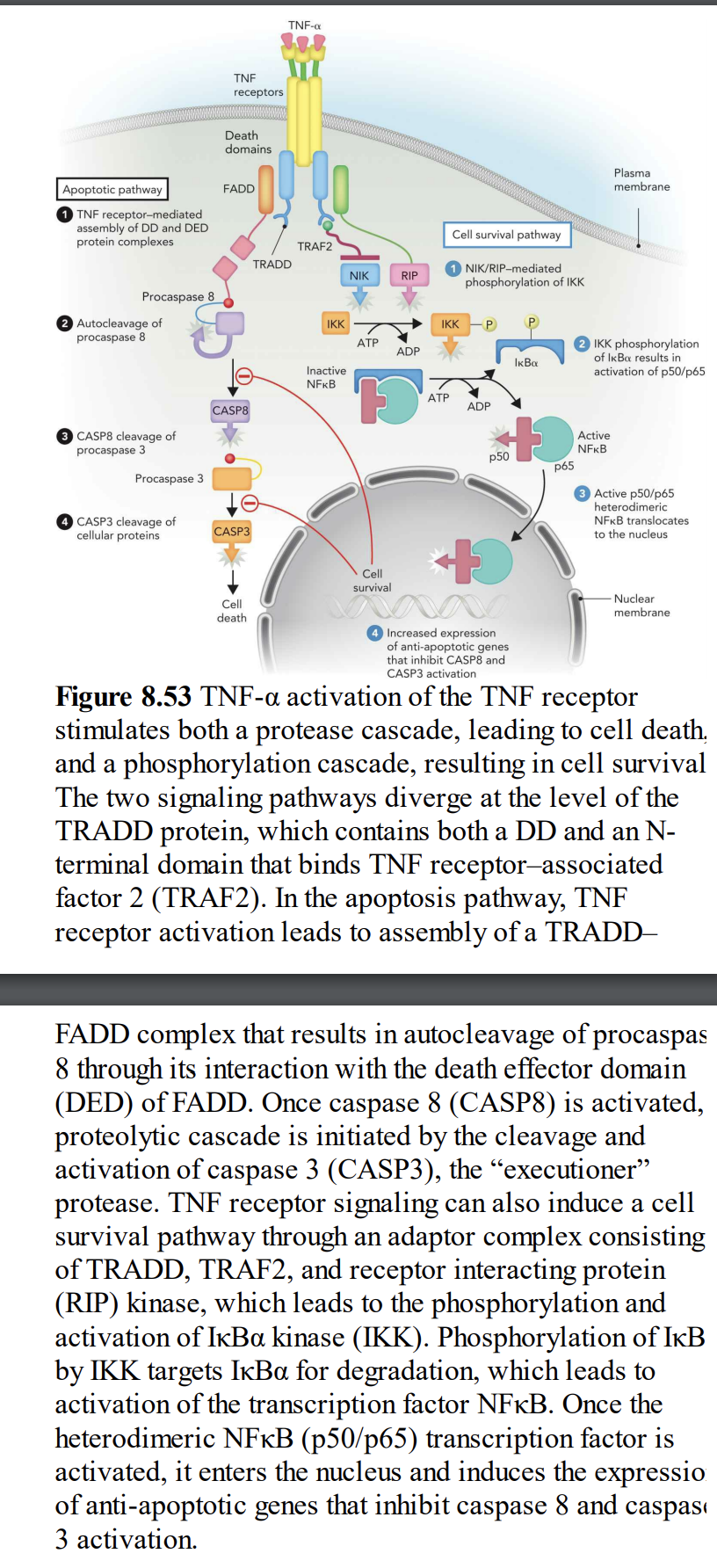Tumor necrosis factor (TNF) signaling Discuss the nature of the TNF ligand and the receptor for that ligand, and explain the general steps in the pathway (use figure 8.53 and explain in your own words). Make sure to include an explanation of the proteolytic and phosphorylation cascades. What advantage is there in having a cascade part of these pathways? What purpose does it serve?
Tumor necrosis factor (TNF) signaling Discuss the nature of the TNF ligand and the receptor for that ligand, and explain the general steps in the pathway (use figure 8.53 and explain in your own words). Make sure to include an explanation of the proteolytic and phosphorylation cascades. What advantage is there in having a cascade part of these pathways? What purpose does it serve?
Biology 2e
2nd Edition
ISBN:9781947172517
Author:Matthew Douglas, Jung Choi, Mary Ann Clark
Publisher:Matthew Douglas, Jung Choi, Mary Ann Clark
Chapter9: Cell Communication
Section: Chapter Questions
Problem 12RQ: Histamine binds to the H1 G-protein-linked receptor to initiate the itchiness and airway...
Related questions
Question
Tumor necrosis factor (TNF) signaling
Discuss the nature of the TNF ligand and the receptor for that ligand, and explain the general steps in the pathway (use figure 8.53 and explain in your own words). Make sure to include an explanation of the proteolytic and phosphorylation cascades. What advantage is there in having a cascade part of these pathways? What purpose does it serve?

Transcribed Image Text:Apoptotic pathway
TNF receptor-mediated
assembly of DD and DED
protein complexes
Procaspase 8
Autocleavage of
procaspase 8
CASP8 cleavage of
procaspase 3
Procaspase 3
O CASP3 cleavage of
cellular proteins
TNF
receptors.
Death
domains
FADD
CASP8
CASP3
Cell
death
TNF-α
TRADD
TRAF2
IKK
Inactive
NFkB
NIK
ATP
RIP
ADP
13
Cell
survival
Cell survival pathway
IKK
ATP
NIK/RIP-mediated
phosphorylation of IKK
P
ADP
p50
+9
Increased expression
of anti-apoptotic genes
that inhibit CASP8 and
CASP3 activation
IkBa
p65
Plasma
membrane.
2 IKK phosphorylation
of IkBa results in
activation of p50/p65
Active
NFkB
Active p50/p65
heterodimeric
NFKB translocates.
to the nucleus
Nuclear
membrane.
Figure 8.53 TNF-a activation of the TNF receptor
stimulates both a protease cascade, leading to cell death,
and a phosphorylation cascade, resulting in cell survival
The two signaling pathways diverge at the level of the
TRADD protein, which contains both a DD and an N-
terminal domain that binds TNF receptor-associated
factor 2 (TRAF2). In the apoptosis pathway, TNF
receptor activation leads to assembly of a TRADD-
FADD complex that results in autocleavage of procaspas
8 through its interaction with the death effector domain
(DED) of FADD. Once caspase 8 (CASP8) is activated,
proteolytic cascade is initiated by the cleavage and
activation of caspase 3 (CASP3), the "executioner"
protease. TNF receptor signaling can also induce a cell
survival pathway through an adaptor complex consisting
of TRADD, TRAF2, and receptor interacting protein
(RIP) kinase, which leads to the phosphorylation and
activation of IkBa kinase (IKK). Phosphorylation of IKB
by IKK targets IKBα for degradation, which leads to
activation of the transcription factor NFKB. Once the
heterodimeric NFkB (p50/p65) transcription factor is
activated, it enters the nucleus and induces the expressio
of anti-apoptotic genes that inhibit caspase 8 and caspas
3 activation.
Expert Solution
This question has been solved!
Explore an expertly crafted, step-by-step solution for a thorough understanding of key concepts.
This is a popular solution!
Trending now
This is a popular solution!
Step by step
Solved in 2 steps

Recommended textbooks for you

Biology 2e
Biology
ISBN:
9781947172517
Author:
Matthew Douglas, Jung Choi, Mary Ann Clark
Publisher:
OpenStax

Biochemistry
Biochemistry
ISBN:
9781305577206
Author:
Reginald H. Garrett, Charles M. Grisham
Publisher:
Cengage Learning


Biology 2e
Biology
ISBN:
9781947172517
Author:
Matthew Douglas, Jung Choi, Mary Ann Clark
Publisher:
OpenStax

Biochemistry
Biochemistry
ISBN:
9781305577206
Author:
Reginald H. Garrett, Charles M. Grisham
Publisher:
Cengage Learning


Human Physiology: From Cells to Systems (MindTap …
Biology
ISBN:
9781285866932
Author:
Lauralee Sherwood
Publisher:
Cengage Learning

Anatomy & Physiology
Biology
ISBN:
9781938168130
Author:
Kelly A. Young, James A. Wise, Peter DeSaix, Dean H. Kruse, Brandon Poe, Eddie Johnson, Jody E. Johnson, Oksana Korol, J. Gordon Betts, Mark Womble
Publisher:
OpenStax College

Biology (MindTap Course List)
Biology
ISBN:
9781337392938
Author:
Eldra Solomon, Charles Martin, Diana W. Martin, Linda R. Berg
Publisher:
Cengage Learning